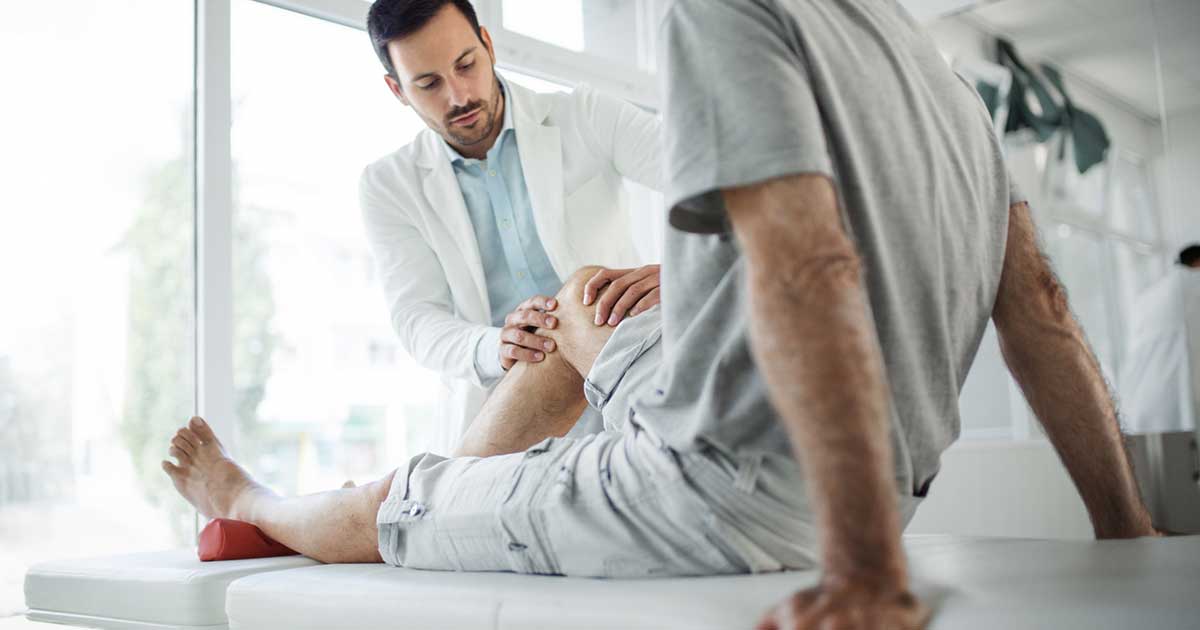Injections for Hip Pain: Cortisone Shots, PRP and More
Advice to improve your movement, fitness, and overall health from the world's #1 in orthopedics.
If you’re experiencing hip pain that isn’t relieved by stretching, exercise or physical therapy, you might be wondering about your options. Hip injections are a common temporary treatment because they tend to be effective for most people, offering quick pain relief and reducing inflammation that may contribute to the discomfort.

The most reliable pain-relieving injection for hip pain is cortisone, says Struan Coleman, MD, PhD, an attending orthopedic surgeon in the Department of Sports Medicine and Hip Preservation at HSS.
Learn more about corticosteroid (also known as cortisone) injections and other types of hip injections and how they work.
Types of Hip Injections
Hip injections usually fall into two categories: diagnostic and therapeutic, the first of which finds the source of the pain and the second of which relieves it, says Dr. Coleman. Hip injections should always be done under radiologic guidance, whether that’s ultrasound or X-ray.
Diagnostic Injections
When pain is persistent, your doctor may suggest injections to find the exact source of your discomfort. They might start with a diagnostic injection of numbing agents like lidocaine and Marcaine as a short-acting test to see if the pain changes. They are given in low concentrations so there’s minimal risk of damage to the cartilage. If the diagnostic injection is in the psoas tendon bursa, it should be done independently of a hip joint injection. “Psoas tendonitis and bursitis can occur in isolation or can be associated with hip impingement or hip dysplasia or in the setting of a total hip replacement,” says Dr. Coleman. If pain outside the hip joint decreases after this test, it suggests that the psoas tendon is at least a part of the issue.
Therapeutic Injections
Therapeutically, steroid injections work by reducing inflammation, which decreases pain. "Steroids deactivate inflammatory cells in the joint, stopping them from triggering pain fibers,” says Dr. Coleman.
Here are types of injections for hip pain your doctor might address with you.
Cortisone Injections
Steroid injections are typically given to two types of patients:
- Someone who has osteoarthritis of their hip. “We know that they need a hip replacement at some point, but they're not ready yet, so we give them a steroid injection for temporary pain relief,” says Dr. Coleman.
- An athlete who’s at the beginning of their season and needs treatment to get through until they can have surgery might get a one-time steroid injection for hip pain.
If you do plan to have a hip replacement in the future, it’s recommended that you wait at least three months after your last steroid injection.
Hyaluronic Acid Injections
This is a gel injection that aims to improve lubrication and decrease inflammation in your joint, done either as one injection or a series of injections a week apart. There’s less data to support their efficacy in the hip area, but they have been done in hip joints with some success.
PRP (Platelet-Rich Plasma) Injections
A PRP injection is created from the patient’s own blood and can be used for many different orthopedic reasons. There’s some data to support that (PRP) these can also be beneficial in people with osteoarthritis of the hip, says Dr. Coleman. PRP can also be injected into a torn tendon to help stimulate reparative cells in the body and kick-start healing for pain relief .
Dr. Coleman uses PRP to help treat trochanteric bursitis, pain on the outside of the hip. “I only use PRP there because steroids can weaken the tendon that's located on the outside of the hip, which creates a big problem,” he says. If you tear that tendon, it’s equivalent to damaging the rotator cuff on the shoulder.
Don’t take nonsteroidal anti-inflammatory drugs (NSAIDs) before or after this injection, as it can impact effectiveness.
Cellular Therapies
“Stem cell” therapy—or, more accurately, “cell therapy—has also been used in the hip for osteoarthritis pain. This type of regenerative medicine was developed to get longer-term relief and offer some protection in the hip joint, because it modulates immune response and it may have the ability to generate fibrocartilage, says Dr. Coleman. Though you can’t get normal cartilage that you’re born with back once you lose it, he says.
What to Expect During and After the Procedure
Hip injections use imaging guidance, typically ultrasound, to ensure precision. The needle is carefully placed into the joint or targeted area, piercing the joint capsule. This process usually results in minimal discomfort and is quick.
After a cortisone injection, patients are advised to limit physical activities for 48 hours. For PRP or stem cell injections, the waiting period can be extended to two weeks to maximize the effectiveness. Follow your doctor’s post-procedure instructions to maximize the benefits of the injection and avoid potential complications.
How Long Do Injections Last?
As with most treatments, it’s highly individualized:
- Cortisone injections: Relief can last from a few weeks to six months.
- Hyaluronic acid injections: HA gel can last four to six months.
- PRP injections: Patients might experience symptom relief of six months to a year.
- Cellular therapies: Relief of discomfort from osteoarthritis might last up to a year with this therapeutic treatment.
While some patients may experience significant pain relief from specific injections, others might find the effect to be minimal. Some physicians will recommend mixing and matching different types of hip injections throughout the year, depending on each patient’s needs.
Risks and When to Avoid Hip Injections
Hip injections come with certain risks. There's a small risk of infection, particularly for patients with compromised immune systems. Patients who already have an artificial joint should avoid steroid injections due to the potential risk of infections. People with diabetes should be aware that there are additional risks for them to get cortisone shots, including a temporary increase in blood glucose levels following steroid injection.
In some situations, injections might not be the best course of action. For example, patients who have severe joint damage might find limited relief from injections, making them candidates for more advanced treatments like surgery.
“Surgery is always the last option,” says Dr. Coleman. If you’re exploring hip arthroscopy, osteotomy or hip replacement surgery, make sure you’ve exhausted all other options first.
Published 11/20/2024





